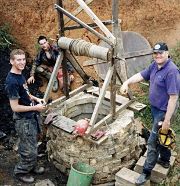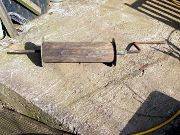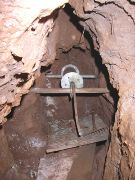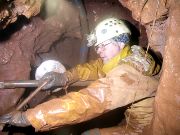Technical Matters
The Windlass
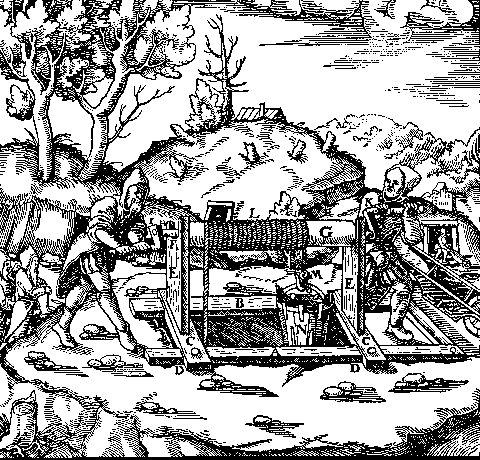
"All windlass workers, whatsoever kind of machine they may turn, are necessarily robust that they can sustain such great toil"
(Georgius Agricola - De Re Metallica - Book VI)
The rationale.
Mendip diggers' attitude to hauling has always struck me as being rather perverse. For both underground and on the surface, people insist on hauling hand over hand on the muddiest, most slippery rope available or sometimes hauling in the same way but using a pulley which has never been oiled and usually shrieks in piteous agony. If occasionally a winch is used, it is invariably a complex metal contraption used in conjunction with a shrieking pulley.
The Old Men didn't work in this way, it's too much like hard work and the alternative, a windlass, is easily made. So why do we?
In the old days, a miner would have taken a log and struck a straight bit of iron in one end and a bendy bit in the other (the handle). Then for use underground, the simplest way would have been to drill a hole in the rock for one bearing and use a slotted lath to support the handle end. On the surface, a simple frame would suffice to support the drum. The photographs below show a windlass above a (collapsed) mineshaft, one above a well (sadly no longer used) and one underground. The quality of the latter photograph is not good, being scanned off a very old 35mm slide, but it's the best I can find.
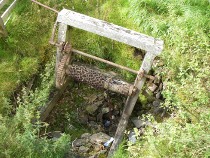
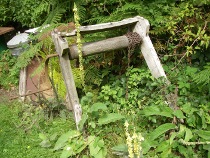
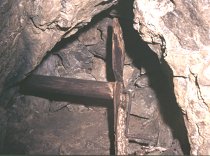
Our version.
[The following images will enlarge if clicked on].
So much for the old days. In more recent times, in fact round about Christmas 2002, I made up a windlass for use at a dig (KD-OFD) at Kingdown, Charterhouse on Mendip. This was partly an experiment just to see how the system would work. It was cobbled together out of a length of telegraph pole, a couple of bits of wrought iron bar and two lengths of water pipe slipped over the bar to act as crude bearings.
The wrought iron rods were heated red-hot in a fire; roughly pointed, then, while they were still hot, bashed into small pilot holes drilled into the pole (lots of smoke). The completed windlass with its bearings was mounted in a frame over the shaft and used with two buckets - one to come up and one to go down!
The system was remarkably easy to use and much better than the tripod, pulley and hand hauling which it replaced. The only disadvantage was that the digger had to dig twice as fast; because as the full bucket was on the way up, an empty was on the way back down, there was no chance to rest.
The photograph shows the windlass being used at KD-OFD in August 2003, the diggers are (L to R), Craig Erwood, John Williams (Tangent) and Richard Jones.
In March 2012, I removed the windlass from the site and then shortened the drum so that it would fit into the space at the top of Tollens' Shaft.
The photograph shows the shortened drum and the water pipe 'bearing' at the handle end. The windlass was designed to fit over the top of Tollens' Shaft supported by two lengths of scaffolding bar. The water pipe 'bearings' were fixed to the bars using modified pig's ear scaff clamps; (modified by being bashed so that they would fit more tightly round the smaller diameter water pipe).
The photograph on the right shows the windlass being tried for position, supported by two scaffold pole stemples. I say being tried, because that was all that happened. The drum was too far to the right for the hauling rope to clear the ledge in the middle of the shaft and there was nowhere for the operator to sit, stand, lie or cower on the right hand side; which was where he needed to be.
So the windlass was taken out and forgotten about for a bit until we had time to enlarge the stance on the right hand side at the top of the pitch.
We created more space on the right side at the top of the pitch in mid June and then refitted the windlass.
So far (July 2012), it has proved much easier than hand hauling. The intention is to use it to haul from the bottom of Ding-Dong, over a length of conveyor belting at the lip of the pitch and then straight up Tollens' Shaft in one go. This should eliminate the need for an intermediate haul and digger at the bottom of Tollens' Shaft, so it should help to speed progress.
The photograph on the left shows Roger Galloway using the windlass. (36 bags came out, it's not just posed).
Measurements.
Imperial (in) Metric (mm)
Drum Length 34 864
Drum Circumference 21 533
Crank Length 12 305
Crank Swept Circumference 75 1905
Advantage Ratio 3.57:1
Drawbacks.
First impressions are that the crank handle is a shade too long for use underground. It was fine for operating from a standing position at KD-OFD, but from a sitting position a shorter crank would be better.
 |
 |
Created: Wed Jul 11 21:40:31 2012
Revised:
